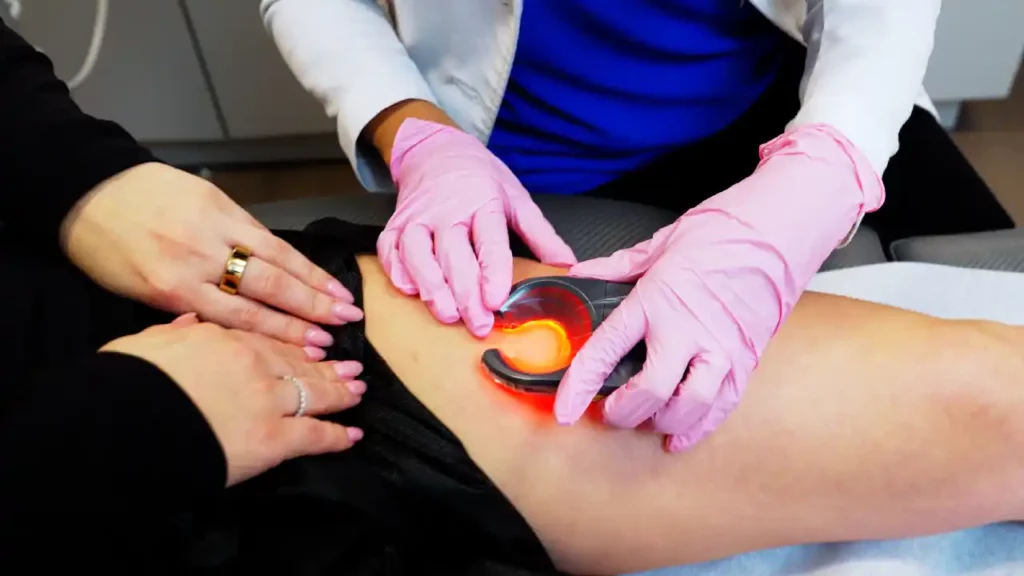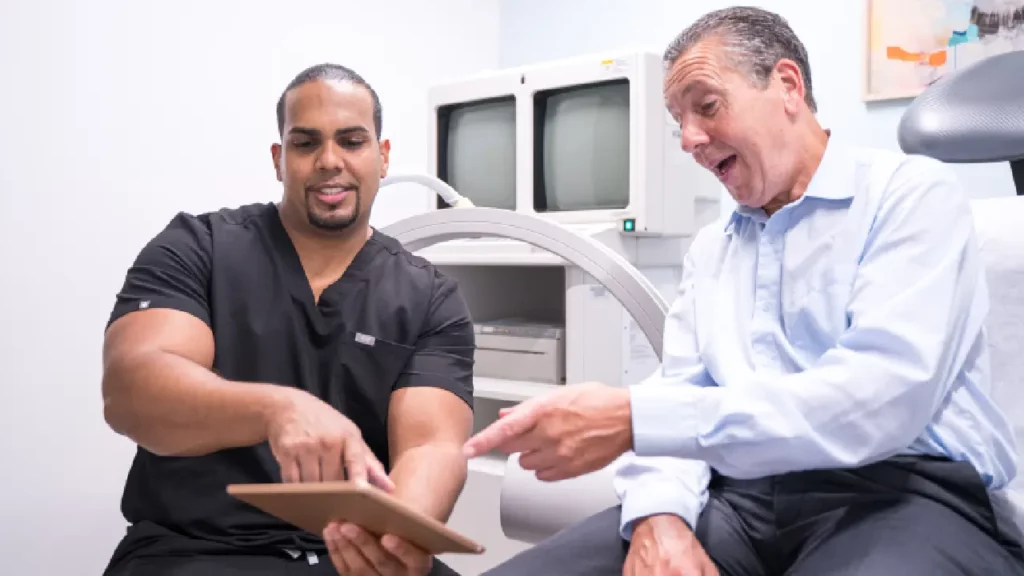An In-Depth Analysis of Spider Veins: Causes, Symptoms, Diagnosis, Treatments, and More
Have you ever wondered why those delicate, thread-like red or blue veins appear just beneath the surface of your skin? Do you feel self-conscious about the appearance of your spider veins or go to great lengths to conceal your legs or skin? Spider veins are dense clusters of damaged blood vessels that appear on your skin’s surface, usually resembling a mass of spider webs. They’re often harmless, but in some cases, they’re also symptomatic of a dangerous underlying medical condition known as chronic venous insufficiency.
The Vein Treatment Clinic is committed to offering reliable and accurate information about spider veins, varicose veins, and other vein conditions. Our team is led by board-certified vein doctors who take the time to examine your leg veins, discuss your symptoms, and administer duplex ultrasound tests to identify the root cause of your spider veins. We also treat the root causes of spider veins and not just the symptoms. Our comprehensive approach to spider vein treatments leads to long-lasting results with minimal risk of recurrence.
Vein Treatment Clinic has state-of-the-art offices across the US, including New York, New Jersey, California, and Maryland. If you have spider veins or other signs and symptoms of vein disease, please schedule a consultation and visit your nearest vein center today.
What Are Spider Veins?
Spider veins, also known as telangiectasias, are small, thin veins that appear near the skin’s surface. They often create a web-like or branching pattern characterized by colors ranging from blue and purple to red. Though typically harmless, they can be aesthetically displeasing and lead to discomfort. Furthermore, while spider veins aren’t inherently dangerous, they can often be symptomatic of chronic venous insufficiency, a dangerous medical condition caused by poor blood flow to the heart.
If your spider veins are symptomatic of vein disease, there’s a higher risk of complications and health problems ranging from ulcers to deep vein thrombosis. Chronic venous insufficiency is often accompanied by symptoms like leg pain, restless leg syndrome, and leg heaviness. If you experience these symptoms, especially at the end of the day or after long periods of sitting or standing still, you must consult our board-certified vein doctors.
However, even if you don’t experience these symptoms, the only way to truly assess if you have underlying vein disease is through a thorough evaluation and diagnosis by our vein doctors.
Are you interested in getting more information about your condition or a treatment?
Fill the form below to start!
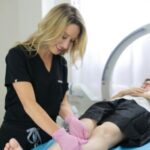
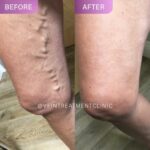
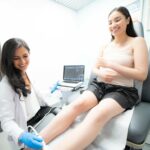
What Are the Signs & Symptoms of Spider Veins?
Spider veins often present as a network of small, colorful veins near the skin’s surface. They may appear as fine lines or clusters of web-like blood vessels. In some cases, spider veins can be accompanied by various symptoms, including:
- Discomfort, such as itching or a burning sensation, in the affected area
- A feeling of leg fatigue or heaviness
- Restless legs, often accompanied by an urge to move them
- Mild swelling around the affected veins
- Skin discoloration or changes in the skin’s texture near the spider veins
If you notice these symptoms, it’s essential to consult our board-certified vein doctors at Vein Treatment Clinic. Our experts specialize in diagnosing and treating spider veins, ensuring you receive the appropriate care and guidance for your vein health.
What Are the Risk Factors for Spider Veins?
Spider veins are essentially damaged blood vessels that appear on the skin’s surface. Several factors can increase the risk of damaged veins and spider veins, including:
- Genetics: A family history of spider veins can increase your susceptibility to the condition. If your parents or grandparents had spider veins, you are more likely to develop them as well. That’s because genes can determine if your vein valves are susceptible to weakening.
- Hormonal Changes: Significant hormonal fluctuations, such as those experienced during pregnancy, menopause, or while taking birth control pills, can weaken the walls of your veins. This weakening makes it easier for spider veins to develop and become visible.
- Prolonged Standing or Sitting: Occupations or lifestyles that involve long periods of standing or sitting can raise the risk of spider veins. Immobility can impede blood circulation in the legs, causing veins to dilate and become visible on the skin’s surface.
- Obesity: Excess body weight puts additional pressure on the veins in your legs. This can lead to the development of spider veins, especially in individuals who are overweight or obese.
- Sun Exposure: Excessive sun exposure can damage the skin and contribute to the formation of spider veins, particularly on the face. Protecting your skin from harmful UV rays with sunscreen and wearing protective clothing can help prevent this.
- Age: The risk of spider veins increases with age. As you get older, the natural aging process can lead to changes in the vein structures, making you more susceptible to spider veins.
- Gender: Women are more likely to develop spider veins than men. Hormonal fluctuations, especially during pregnancy and menopause, can lead to the weakening of vein valves, which directly contributes to chronic venous insufficiency and the development of spider veins.
- Previous Vein Issues: Individuals with a history of varicose veins or blood clotting disorders, such as deep vein thrombosis, may have an elevated risk of developing spider veins.
- Injury or Trauma: Past injuries or trauma to the affected area can damage veins and lead to the development of spider veins. It’s essential to seek medical attention for injuries and consider preventive measures if you have a history of accidents or physical trauma.
What Is the Root Cause of Spider Veins?
Spider veins are often the result of an underlying condition known as chronic venous insufficiency. Normal veins have one-way valves that help direct blood flow toward the heart. These valves open to allow blood to flow upward and then close to prevent it from flowing backward. This mechanism ensures efficient circulation. However, when these valves become weakened or damaged, as is the case with venous insufficiency, problems arise.
Chronic venous insufficiency occurs when the valves in the veins of the legs fail to function correctly. This leads to a reverse flow of blood, causing it to pool in the leg veins. As blood accumulates in the veins, it exerts increased pressure on the vein walls. Over time, this elevated pressure weakens the walls of the veins, causing them to dilate and become visible on the skin’s surface as spider veins or varicose veins.
In essence, spider veins are a visible symptom of an underlying issue—chronic venous insufficiency. Addressing the root cause by diagnosing and treating CVI is crucial for effectively managing and preventing the recurrence of spider veins.
What’s the Difference Between Spider Veins and Varicose Veins?
Spider veins and varicose veins are both common vein conditions that affect many individuals, but they have distinct differences in appearance, symptoms, and severity. Understanding these differences is crucial for proper diagnosis and treatment.
Appearance and Size
Spider veins are small, thin veins that appear near the skin’s surface. They often form a web-like or branching pattern of blue, purple, or red lines. These veins are typically less than 1 millimeter in diameter and can be as fine as a spider’s web, hence the name. Varicose veins are larger and more prominent. They appear swollen and often bulge above the skin’s surface. Varicose veins can be several millimeters in diameter and may cause the affected leg to appear twisted or rope-like. Unlike spider veins, they are not fine and delicate.
Root Causes
Spider veins are primarily a cosmetic concern and are often associated with chronic venous insufficiency (CVI) or hormonal changes. They are a result of weakened or damaged blood vessels near the surface of the skin. Varicose veins are a more significant medical issue and are primarily caused by the failure of the valves within the veins. When these valves do not function properly, blood pools in the veins, leading to their enlargement and distortion. Varicose veins are often a sign of venous insufficiency, and they can cause discomfort and other symptoms.
Symptoms and Complications
Spider veins are asymptomatic, meaning they do not cause pain or discomfort. However, they can be itchy or cause a burning sensation. Varicose veins are more likely to cause symptoms like aching, throbbing, swelling, and a feeling of heaviness or fatigue in the legs. Spider veins are often caused by CVI, and varicose veins are almost always caused by underlying CVI. In both cases, venous insufficiency can eventually lead to skin changes, venous ulcers, and blood clots, making them a medical concern beyond their cosmetic impact.
What Happens if I Don’t Treat Spider Veins?
Spider veins may seem like a minor cosmetic concern, but ignoring them can have consequences for your vein health and overall well-being. Here are some potential outcomes if you choose not to treat spider veins:
- Progression of Vein Issues: Spider veins are often an indicator of underlying venous insufficiency. If left untreated, this condition can worsen over time, leading to the development of larger varicose veins and more significant symptoms.
- Increased Discomfort: While spider veins themselves may not cause discomfort, chronic venous insufficiency (CVI) can lead to symptoms like leg pain, swelling, aching, and a feeling of heaviness. These symptoms can become more pronounced without treatment.
- Skin Changes: Prolonged venous insufficiency can result in skin changes around the affected area. This includes skin discoloration, thickening, and the development of red or brown patches. These changes can be unsightly and challenging to reverse.
- Leg Ulcers: Severe CVI can lead to the formation of venous ulcers, which are open sores on the skin. These ulcers are often painful, slow to heal, and prone to infection. Managing venous ulcers can be challenging and may require ongoing medical attention.
- Blood Clots: While less common, untreated venous insufficiency can increase the risk of blood clot formation. These clots can be dangerous, potentially leading to deep vein thrombosis (DVT) or even pulmonary embolism if they travel to the lungs.
- Reduced Quality of Life: The discomfort, pain, and aesthetic concerns associated with untreated spider veins and venous insufficiency can significantly impact your quality of life. Activities that require prolonged standing or sitting may become more difficult, and your self-esteem can suffer due to visible vein issues.
While spider veins may appear minor, it’s essential to address them promptly to prevent potential complications and improve your overall vein health. Please consult our vein specialist to determine the most appropriate treatment tailored to your specific condition and needs.
Can I Treat Spider Veins With Natural Remedies?
We are often asked if spider veins can be treated using natural remedies or home remedies. We have been asked about the efficacy of numerous treatments for spider veins, ranging from essential oils to apple cider vinegar and witch hazel. Most of these natural remedies are ineffective at best and actively harmful at worst if handled incorrectly. There’s no clinical evidence to support that these home remedies can improve spider veins.
Spider veins are damaged blood vessels caused by malfunctioning vein valves that allow blood to accumulate in the leg veins. The only way to treat spider veins is to address the root cause, restore optimal blood flow to the heart, and remove the damaged veins. Some home remedies may provide temporary relief from some of the symptoms of spider veins and varicose veins, but they can’t treat venous insufficiency or visible vein problems.
However, if you want to prevent your vein problems from worsening, you can try these:
- Exercise: Regular physical activity, such as walking or swimming, can help improve circulation and may alleviate symptoms associated with spider veins.
- Leg Elevation: Elevating your legs above heart level for short periods can reduce swelling and promote blood flow. However, this is more of a symptom-management technique.
- Compression Stockings: Graduated compression stockings, when worn as prescribed, can help improve blood flow in the legs and reduce discomfort associated with spider veins.
- Dietary Changes: A diet rich in fiber and antioxidants may support vein health by improving circulation. Include fruits, vegetables, and whole grains in your meals.
- Maintain a Healthy Weight: Obesity is a risk factor for spider veins, so maintaining a healthy weight can reduce the likelihood of their development.
- Avoid Prolonged Standing or Sitting: If possible, take breaks and change positions regularly if your daily routine involves prolonged standing or sitting. This can help prevent blood pooling in the leg veins, thus preventing spider veins from worsening.
While these lifestyle changes may offer some relief and promote overall vein health, they are not considered primary treatments for existing spider veins. If you have spider veins or suspect an underlying venous issue, it’s essential to consult a board-certified vein specialist. Minimally invasive vein treatments are the most effective way to address spider veins, especially when they cause discomfort or cosmetic concerns. Our vein doctors can evaluate your condition and recommend the most appropriate treatment plan tailored to your specific needs.
How Are Spider Veins Diagnosed?
At Vein Treatment Clinic, our board-certified vein doctors are committed to providing you with the most accurate diagnosis and treatment plan for your spider veins. Our comprehensive diagnostic process involves a combination of thorough physical examination, symptom assessment, and advanced imaging techniques such as duplex ultrasound tests.
Physical Examination
During your initial consultation, our experienced vein specialists will conduct a physical examination of the affected areas. This examination involves visually inspecting your legs for the characteristic appearance of spider veins. The doctor will assess the size, location, and extent of the spider veins to determine their severity.
Symptom Assessment
Our vein specialists will discuss your symptoms and medical history. If you are experiencing any discomfort, itching, burning sensations, or swelling associated with your spider veins, it’s crucial to provide this information during the assessment. Understanding your symptoms is an essential part of the diagnostic process and helps us develop an accurate treatment plan.
Duplex Ultrasound Tests
To precisely diagnose the root cause of your spider veins and rule out more serious vein conditions, we often use duplex ultrasound tests. This non-invasive imaging technique allows us to visualize the veins beneath the skin’s surface in real time. By assessing blood flow patterns and identifying any underlying venous insufficiency or reflux, duplex ultrasound tests provide critical information for creating a personalized treatment plan.
At Vein Treatment Clinic, we prioritize a comprehensive and accurate diagnosis to ensure that your spider vein treatment is targeted and effective. Our commitment to utilizing advanced diagnostic tools and conducting thorough assessments enables us to address both the cosmetic and medical aspects of your vein health. Once the diagnosis is complete, we can curate a treatment plan tailored to your specific needs.
How Are Spider Veins Treated?
At Vein Treatment Clinic, we are dedicated to providing personalized, minimally invasive treatments for spider veins. However, our approach goes beyond simply addressing the visible symptoms. We understand the importance of treating the underlying causes, especially chronic venous insufficiency (CVI). Treating spider veins without addressing the root cause is like painting over a stained wall without fixing the leaky pipes underneath — doomed to failure.
Compression Stockings
Compression stockings are often recommended as an initial treatment for spider veins. These specially designed stockings apply graduated pressure, with the highest compression at the ankle and gradually decreasing pressure as they move up the leg. This helps improve blood flow in the veins, reducing the swelling and discomfort associated with spider veins. While compression stockings can provide relief, they do not eliminate spider veins.
Sclerotherapy
Sclerotherapy is one of the most common and effective treatments for spider veins. During this minimally invasive procedure, a specialized solution is injected into the affected veins. This solution irritates the vein walls, causing them to collapse and turn into hardened scar tissues. The accumulated blood reroutes into healthier leg veins, improving overall blood circulation. Over time, the hardened spider veins get metabolized by the body and fade away.
Other Minimally Invasive Vein Treatments
While sclerotherapy is an excellent option for treating spider veins, it does not address the underlying chronic venous insufficiency that may be causing them. When you are diagnosed with vein disease, our vein doctors prioritize treating the root cause before targeting spider veins to ensure long-lasting results. Here are some other minimally invasive vein treatments:
- Endovenous Laser Ablation (EVLA): EVLA involves the use of laser energy to close off problematic veins. A tiny laser fiber is inserted into the affected vein, delivering heat that causes the vein to seal shut. Blood is then naturally rerouted to healthier veins.
- Radiofrequency Ablation (RFA): RFA is a similar procedure to EVLA but uses radiofrequency energy instead of laser energy to heat and close off the problematic vein. It is an effective and minimally invasive way to treat underlying vein disease.
- VenaSeal: VenaSeal uses a medical adhesive to close off the diseased vein. A small catheter is inserted into the vein, and the adhesive is applied, sealing the vein shut. This procedure provides rapid relief from CVI symptoms and allows for a quick return to daily activities.
These minimally invasive treatments not only alleviate the discomfort associated with CVI but also help improve the overall health of your veins. By addressing the root cause of your vein issues, we can ensure that any subsequent treatment for spider veins is more effective and offers lasting results. Our experienced vein specialists at Vein Treatment Clinic will assess your condition and recommend the most suitable treatment plan tailored to your needs.
What Are the Benefits of Minimally Invasive Spider Vein Treatments?
Minimally invasive treatments for spider veins offer numerous advantages, making them a popular choice among patients seeking relief from this condition. Here are the benefits:
- Highly effective at eliminating spider veins, improving the appearance of your legs
- Associated with minimal discomfort and usually require only local anesthesia or none at all
- Recovery times are short, allowing you to return to your normal activities immediately
- Involve tiny incisions or injections, resulting in minimal scarring, if any
- Precisely target the affected veins, leaving surrounding healthy veins unaffected
- Associated with a lower risk of complications compared to more invasive surgical options
- Blood flow is redirected to healthier veins, improving overall circulation
- Offer long-lasting results, reducing the risk of vein issues returning
- Performed on an outpatient basis, allowing you to go home the same day
What Happens After Minimally Invasive Spider Vein Treatments?
After undergoing minimally invasive spider vein treatments, you can expect a relatively smooth recovery. Most patients experience minimal discomfort and can resume their regular activities shortly after the procedure. You may notice improvements over a few weeks as the spider veins harden and then get absorbed by the body. However, it’s essential to follow the aftercare guidelines provided by your vein specialist to ensure optimal results:
- Engage in light walking or gentle leg exercises to promote blood circulation.
- Wear compression stockings as directed to aid in healing and maintain proper blood flow.
- Protect the treated areas from direct sunlight, as exposure can lead to skin discoloration.
- Apply sunscreen and wear protective clothing when going outdoors.
- Stay well-hydrated to support the healing process and overall vein health.
- Avoid hot baths, saunas, and activities that expose your legs to excessive heat.
- Attend scheduled follow-up appointments with your vein specialist to monitor your progress.
- Engage in regular physical activity, such as walking or swimming.
- Elevate your legs when resting or sleeping to promote blood flow back to the heart.
- Opt for loose-fitting clothing that doesn’t constrict blood flow to the treated areas.
How Can I Prevent the Recurrence of Spider Veins?
Once spider veins have been successfully treated, those same veins won’t return. However, new spider veins can potentially develop in the future. While there are no foolproof methods to guarantee the prevention of spider veins, several lifestyle changes can reduce the risk:
- Engage in regular physical activity to improve circulation and strengthen leg muscles.
- Maintain a healthy weight through a balanced diet and exercise.
- Whenever possible, elevate your legs above heart level to reduce pressure on your veins.
- Take breaks if your job involves extended periods of standing or sitting.
- Wear graduated compression stockings to support healthy blood flow and reduce vein strain.
- Consume a diet rich in fiber, antioxidants, and vitamins to promote cardiovascular health.
- Maintain regular check-ups with your vein specialist to monitor your vein health.
While it’s challenging to completely prevent the appearance of new spider veins, these lifestyle changes can help minimize the risk of recurrence and promote overall vein health. Please consult our vein specialist for additional guidance and personalized recommendations based on your specific needs and risk factors.
Schedule Your Consultation Today
If you’re dealing with spider veins or suspect an underlying vein issue, scheduling a consultation with our board-certified vein doctors at Vein Treatment Clinic is the first step towards healthier, more attractive legs. Our team is dedicated to providing you with comprehensive vein care, from accurate diagnosis to personalized treatment plans.
During your consultation, our experienced vein specialists will assess your condition, discuss your symptoms, and answer any questions you may have. We’ll work closely with you to develop a tailored treatment approach that addresses both the medical and cosmetic aspects of your vein health. With state-of-the-art facilities across the United States, we ensure your spider vein treatments are as smooth and effective as possible. Schedule your consultation at your nearest vein treatment clinic in New York, New Jersey, California, or Maryland.







